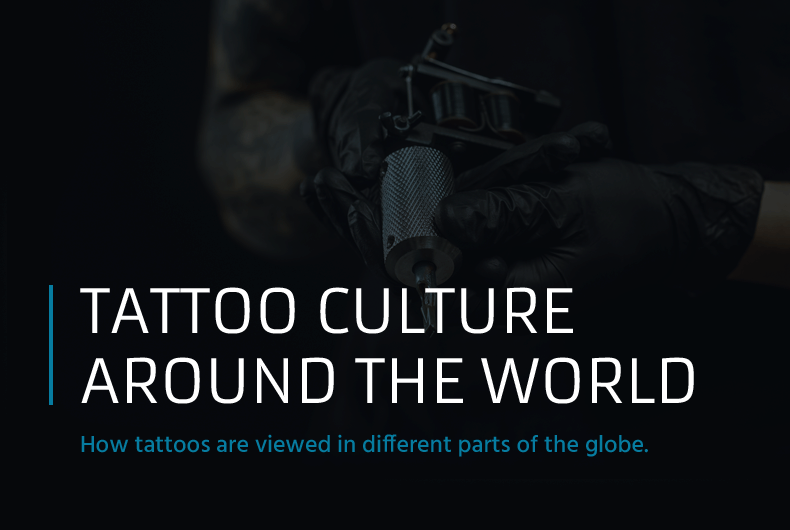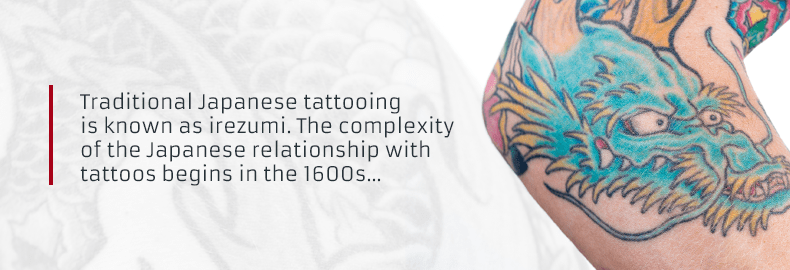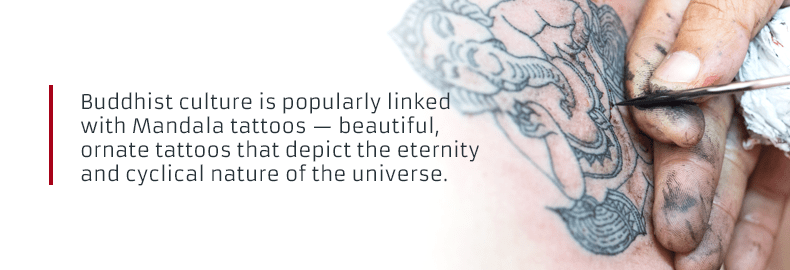
Tattoo Culture Around the World
In recent years, society has undergone a remarkable transformation regarding our views on tattoos. Those of us born in the 1980s or before have likely noticed this — tattoos were once a taboo here in America. They were hidden from parents. They had to be concealed from potential bosses. If you had any aspirations of an upper-class lifestyle, a visible tattoo would have served as a potential barrier to entry.
Somehow, that has all changed.
Now, tattoos adorn the skin of around 40% of all Americans between the ages of 26 and 40. It is no surprise to see them on our bosses or our school teachers. Tattoos are now seen as a form of expression that is as valid as pierced ears or hairstyle. Just like pierced ears and hair, certain tattoos can still cause alarm, but they are far less likely to inspire a startled gasp than they once were.
What is truly incredible is how different cultures view tattoos around the world. While we in America have a complicated history with them, in many cultures they are seen as a symbol of purity. They can be a rite of passage, ensuring societal acceptance. They may be the only means of being viewed as beautiful. They may also represent a religious ritual.
Tattoo culture around the world holds plenty of surprises for those who have grown up with the American interpretation. Here is how tattoos are viewed in different parts of the globe.
Tattoos in Japan
Japan has had a complicated history with tattoos. Anyone who has visited the island nation has likely seen the “no tattoos allowed” signs at public bathing facilities, saunas, gyms and more.
As it turns out, a large part of Japan’s aversion to tattoos is thanks to the yakuza, or the Japanese mafia. Traditional Japanese tattooing is known as irezumi. The complexity of the Japanese relationship with tattoos begins in the 1600s, when the government enacted a policy that all criminals must be tattooed — an act known as bokkei. This would make it difficult for them to gain acceptance again in society. This policy of branding endured for over 200 years.

The yakuza’s tattoo culture formed as a protest against bokkei. The full-body tattoo was a creation of the yakuza and continues to be popular to this day. Even today, though fewer yakuza members get tattoos so as to be able to go unnoticed in society, the process is still seen as a rite of passage.
Casting the group’s obvious unsavory nature aside for a moment, their tattoos are remarkable. Rich in symbolism, Japanese tradition and storytelling, they include staples such as the koi fish, dragon, phoenix, snake and others.
Maori Tattoos
The Maori people of New Zealand have a rich history of tattoos. Originally thought to have reached the Maori via east Polynesia, tattooing became an integral part of their culture. Because the Maori considered the head to be body’s most sacred part, they focused heavily on facial tattoos. If a Maori was highly ranked, it was certain that the person would be tattooed. Similarly, anyone without status would likely have no tattoos.
The practice of tattooing started at puberty. A sacred ritual, it took place as part of a religious practice. Tattoos made warriors more attractive to women and more fearsome to opponents. Due to the rudimentary and painful nature of the tattooing process, a person would often be rendered bedridden for many days while the swelling reduced and the tattoo wounds healed.
The fascinating fact here is that, while tattoos are often seen as rebellious in western culture, in Maori culture they were expected. To refuse to be tattooed was the rebellious act.
The New Zealand government banned Maori tattoos in 1907 with the Tohunga Suppression Act, which intended to replace traditional Maori practices with modern medicinal practices. This act served, tragically, to threaten Maori culture as a whole. Fortunately, it was repealed in the 1960s, and Maori tattoos have since made a comeback.
As a last interesting note, the word “tattoo” comes from a Tahitian word “tattau,” meaning to strike or tap.
Tattoos in Africa
Africa has one of the oldest histories with tattoos anywhere in the world. From an Egyptian mummy found with a tattoo dating to near 2000 BCE to an example found in Libya, Africa offers a rich history of tattoos. While the Egyptian tattoos are believed to have symbolized things like fertility and worship of the gods, they have other meanings in other parts of Africa.
North Africa has largely seen tattooing as taboo due to its Islamic influences throughout history. Tattoos are seen as akin to spraying graffiti on the body, which is a gift from Allah. Regardless, there is still some history of tattoos throughout North Africa, perhaps as a subculture and perhaps born out of rebellion.
In sub-Saharan Africa, there is a unique practice of tattooing known as skin scarification. In it, a practitioner uses an instrument with a sharp blade to cut the skin in particular patterns. Eventually, scar tissue forms over the wound and the shape remains. Though dangerous due to the risk of infection, these scars were used to ward off evil.
Today, a similar process called cicatrization is widely used. In it, the artist cuts the skin deeply and then rubs soot or ash into the wound. The soot or ash causes the skin over the wound to protrude upward, allowing for a three-dimensional raised scar. Normal tattoos have also gained popularity. In many tribes, the complexity of tattoos reflects the social status of the person.
Tattoos in India
Tattooing has been common for many centuries in tribes scattered across the vastness of the Indian subcontinent. The tribes would view the tattoos as unstealable jewelry, or as a means to make young women seem unattractive to neighboring tribes who might otherwise steal them. In the northeast, headhunters would bear facial tattoos that recounted how many lives they had taken.
In the intoxicating heat of southern India, permanent tattoos have long been a tradition. Referred to as pachakutharathu, they only ceased being popular around 1980. The tattoo artists would travel around creating tattoos of labyrinth-like snares on people’s bodies so that they could ward off evil.
The Indian subcontinent is home to such a long and complex history of inhabitants that it is impossible to recount all the tattoo traditions present. In some cultures, tattoos were a means of marking those in lower castes so as to keep them down in society.
Today, tattoos have begun to take a similar form as in western culture, with young people getting them as a fashion statement. This represents the opportunity for Indians to keep their histories alive in body art while moving into the country’s fast-developing future.
Tattoos in the United States
Tattoos in the United States can be divided into two epochs: tattoos in pre-colonial Native American culture, and those in contemporary American culture.
Perhaps the most popularized instance of Native American tattoos entering the minds of the British can be found in the trip of four Mohawk men to London in the early 1700s. These men were tattooed across their chests, faces and arms, and the fervor they created in London can hardly be overstated. People were enraptured by the tattoos and the men themselves. It served as a microcosm of Western views of natives — people at once admired the men as noble while scorning them as savages.

In any event, tattoos were common among tribes in America. They were created using sharpened instruments like needles and bones to prick the skin, then by rubbing dark soot into the open wound. Tattoos were a means of celebrating achievements in life and in warfare.
In the modern United States, tattoos were once seen as fit for misfits, sailors and motorcyclists. However, perhaps aided by the television show Miami Ink, tattoos have become widespread and popular among young people. This show served to show the glamour and artistry involved in tattooing. It shifted the public perception of tattoo parlors as cool places to work and to be. This trend continues to evolve today.
Tattoos in China
China’s relationship with tattoos dates back several millennia. Known as ci shen in Mandarin, it has had a complicated history — usually seen as a distasteful degradation of the body. In the classic Chinese novel Water Margin, 12th-century bandits are described as being tattooed, with three of them even sporting full-body tattoos.
Perhaps the best-known tattoo story involves Yueh Fei of the South Song Dynasty. In a battle with enemies to the north, a superior above Yueh Fei defected to the enemy’s side. Yueh Fei protested this move by leaving the army and going home. His resignation was met with an unexpectedly hostile response from his mother, who scorned him for abandoning his country. She kindly reminded him of his allegiance by tattooing jin zhong bao guo across his back: “serve his country with ultimate loyalty.”
Similarly to Japan, China has a history of marking criminals with tattoos. Those who had committed a serious crime could be exiled and marked with a tattoo, ensuring they would never re-enter society without being noticed. Also like Japan, there is a stigma with tattoos being associated with organized crime. However, in a country with over 1.3 billion people, tattoos are also a part of youth culture and fashion.
Tattoos in Buddhist Culture
Buddhist culture is popularly linked with Mandala tattoos — beautiful, ornate tattoos that depict the eternity and cyclical nature of the universe. Not only are these tattoos unique to Buddhism, they are are also unique to each person.
The Thai name for such tattoos is Sak Yant. In essence, it involves tattooing sacred, geometrical patterns and designs on one’s skin. Different religions have influenced Sak Yant tattoos over the centuries. The patterns inscribed by Brahmin holy men in India greatly influenced Buddhist design in Thailand.

Originally, Sak Yant was not part of Buddhism. The religion itself spread throughout Asia, absorbing and mixing with local traditions like water flowing through a series of pools. Shamanistic traditions blended Sak Yants into the Buddhist tradition. Thai Buddhism today has many sects that incorporate Sak Yant into their practices. If a monk wishes to get a Sak Yant, they must seek out an ajarn or qualified monk to perform it. Even though not all monks have them, they are widely accepted in Thailand.
Christian missionaries disapproved of the Sak Yant when they began infiltrating Thai cities in the late 1800s. This caused the tattoos to lose popularity over the coming century. Interestingly, it was Angelina Jolie’s Sak Yant tattoo that is often attributed with their resurgence in popularity.
Tattoos in the Far North
Inuit facial tattoos have a dark and beautiful history among the people of northern Canada and Greenland. A mask found on the remote arctic Devon Island dates back 3500 years and shows facial tattoos similar to those on natives in modern-day Nunavut. In fact, many of the characteristics of these facials tattoos — their lines from lip to chin, their arrowheads on the cheeks and their converging forehead lines — can be found in native arctic peoples around the globe.
The unfortunate story in the North American Arctic, however, is that facial tattoos were forbidden for most of the twentieth century.
Why did this happen? As is too often the case in native histories, facial tattoos were seen as a native custom that needed to be suppressed. With it, the customs and culture of the Inuit might also be suppressed, allowing the government to be one step closer to a culturally united nation.
What was lost with these facial tattoos? The practice was largely for women. It signified a coming of age and a readiness for marriage, in which she had mastered several key skills — chopping and melting ice for drinking water, creating and maintaining boots out of sealskin, extracting fat from seals for lighting. Tattoos were administered by an elder woman in the tribe, using bones, steel or wood for the needle. Tattoos were made on the cheeks, chin, forehead, lips, eyes and eyebrows, as well as on collarbones and other parts of the body.
There is a happy ending to this story, however: facial tattoos have reemerged in the Arctic. Women looking to honor their culture and history have begun taking facial tattoos on again.
Come to MEDermis Laser Clinic for Tattoo Removal

As we approach 300,000 successful laser tattoo removal treatments, MEDermis has expertise that no other tattoo removal clinic can come close to. We perform our successful removals by utilizing the most state-of-the-art laser technology designed specifically for tattoo removal.
With locations in both Austin and San Antonio, MEDermis is the preeminent tattoo removal clinic in each city. Our focus, knowledge, experience and laser are what make us different. Because we are the pioneers in laser tattoo removal, we have set ourselves apart as trusted experts in the state of Texas. We are passionate about helping people get their skin back, whether it is for permanent tattoo removal or to start fresh with new ink.
We are proud to have successfully removed the most tattoos in the country. Our rate of 95 to 98 percent ink clearance sets us apart both in Texas and nationwide, as well as our 12 years of service.
Come to MEDermis Laser Clinic to give your skin the crisp, clean second start it deserves. Schedule your free consultation now.
